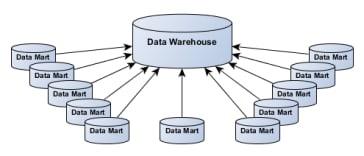Most big data solutions are dominated by data warehouses and data lakes for performing big data analytics. But having a Data Mart Setup plays a significant role in turning data into insights, more efficiently. This use case covers the general pros and cons of a Data Mart along with steps to set up your own Data Mart.
More...
This post was originally published in Hevo Data.
Use Case: Data Mart Setup

Problem Statement
Data warehouses become inefficient over time due to large amounts of diverse data ingested from multiple sources across an entire organization, resulting in reduced query performance and higher costs.

Realization Approach
A custom data pipeline built using Hevo Data that focuses on a smaller and scaled down dataset belonging to a specific domain, results in a data mart which is tailored to the needs of specific business units or functional areas, such that it leads to better alignment between the data and the business requirements.

Solution Space
Due to their smaller scale and limited scope, data marts are less expensive to build and operate, and offer better query performance to address specific business needs and can be modified or expanded as those needs evolve, without impacting the entire data warehouse.
During data analytics, individuals normally want to access data quickly and with a lot of ease. This is impossible with a data warehouse, which requires one to create complex queries just to access data for generating simple reports. This explains the reason why smart companies prefer storage and access to data using this method. Instead of storing data for an entire company, a Data Mart stores a subset of data that serves the needs of a particular department.
What is a Data Mart?

A Data Mart is a smaller version of a data warehouse and it is meant to be used by a particular department or a group of individuals in the company.
It focuses on a single functional unit of an organization and keeps a subset of data stored in the data warehouse. It is normally controlled by a unit department in the organization. Whereas a data warehouse draws data from many sources, a Data Mart draws data from only a few sources.
Since these storages are smaller in size, they are easy to create, and maintain, and are more flexible. Its objective is to provide the business user with the most relevant data in the shortest time possible. This prevents the user from having to wait for longer periods of time for queries to complete. They also facilitate the summarization of data. Data warehouses store a broader range of data, which is not summarized, making it difficult to sort through masses of data and increasing query times.
Why Create a Data Mart?
A Data Mart offers easier access to data needed by a particular team or line of business within your organization. For instance, if your marketing team is looking for data to help improve campaign performance during the holiday season, combining and sifting through data across various systems could turn out to be costly in terms of accuracy, time, and money.
Teams that are forced to locate data from multiple sources quite often depend on spreadsheets to migrate this data and collaborate. This could lead to confusion, human errors, complex reconciliations, and multiple sources of truth. Therefore, these tools have become increasingly popular as a centralized place where the required data is organized and collated before dashboards, reports, and visualizations are generated.
What are the Advantages of a Data Mart?
A few advantages of the Data Mart are listed below:
- Data Marts are efficient, and cost-effective solutions as they take are cheaper to deploy than Data Warehouses and data access.
- Hybrid Data Marts can improve performance by taking a Data Warehouse processing. When dependent data marts are placed in a separate processing facility, they significantly reduce analytics processing costs as well.
- Data Marts can be independent of each other, so any error in the central Data Warehouse doesn’t affect individual Data Marts.
What are the Disadvantages of a Data Mart?
A few disadvantages of the Data Mart are listed below:
- In an independent Data Marts model, the business may not have ready to access data cross-data-mart reporting
- Deploying Data Marts can sometimes be cumbersome because it is important to align fields. If it is not handled properly, there might be errors in building reports to run across Data Marts.
- One needs to first identify the company’s requirements. Data Marts are not always the right solution for every group.
What are the Data Mart Use Cases?
Here are a few pivotal use cases where Data Marts can come in handy:
- Improved Resource Management: You can provide each department with a separate repository to manage the imbalance of resource use by various organizational units. For instance, if the department running logistics operations performs a lot of actions with a database on a daily basis, then this might cause system malfunctions in other departments that carry out fewer database queries. Eventually, this might end up reducing the performance effectiveness of the entire company. These repositories allow you to use resources more effectively and efficiently.
- Subject-focused Data Analytics: Data Analytics plays a pivotal role in any business lifecycle. These repositories allow for more focused data analysis since they only contain records that are organized around particular subjects like sales, products, customers, etc. Since there is no extraneous information to deal with, businesses can filter more accurate and clearer insights.
- Selective Data Access: You can leverage these repositories in situations when an organization needs selective privileges for managing and accessing data. Generally, this can be the case for big enterprises that can’t reveal the entire Data Warehouse to all the users. By building multiple dependent repositories, you can help protect sensitive data from accidental writes and unauthorized access.
- Time-limited Data Projects: As opposed to corporate data warehouses that need considerable effort and time, these are much easier and faster to set up. Since, data developers and engineers work with smaller amounts of data, simpler schemas, and fewer sources, this comes in handy. Apart from this, these repositories are also easier to implement compared to a Data Warehouse. So, if you are facing any time crunches in terms of completing a data project, these repositories may be the way to go.
For a detailed analysis of data mart types, and setup steps, check out the original post.


